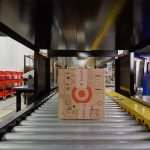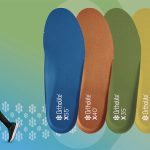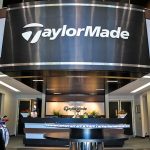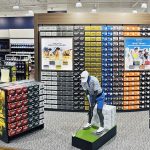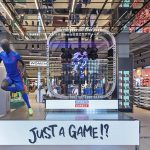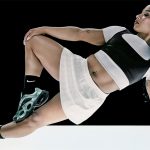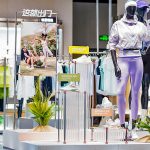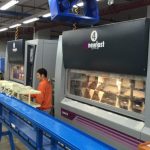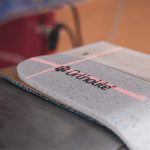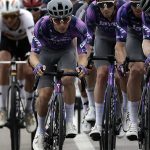In March, Sam Sato became EVP and CMO of The Finish Line chain. Previously, Sato spent 22 years at esteemed high-end chain Nordstrom, most recently overseeing the entire mens shoe business. Under Satos leadership, the athletic business at Nordstrom grew by 70 percent and sales in the junior segment doubled over two years.
| SEW: | How has the transition from Nordstrom to The Finish Line been? |
The transition has been fine. Its been fast and furious. As you know, in our business theres no down time. Everyday weve got to challenge ourselves to improve. And so its been a great transition in terms of the people getting to know the way we operate here. That continues to be a priority for me. I really think there is incredible opportunity with Finish Line. Were going to continue to access our business and were going to look for ways to evolve our stores and our product assortments and improve consistently. | |
| SEW: | What merchandising changes do you have planned? |
Obviously, in the two-and-a-half months Ive been here, were still in transition and were going to continue to look at all the businesses we currently offer and make the appropriate determinations on where that fits into our business near- and long-term. We have to develop a strategy that aligns our assets-both people and our inventories-with those opportunities that we see moving forward. Clearly, were going to continue to evolve our product offering to really fulfill the demands of our core customer. And thats around performance product, but its also around those trend-relevant fashion/sports style products that are obviously on-trend today. | |
| SEW: | What is causing the weakness in the athletic footwear sector? |
| SS: | Within performance, which is a large part of our business, I really think its the lack of newness thats hurt the category. Were navigating through the whole sports style concept in those brands that drive and lead that part of the business. Right now, our goal in both performance as well as our sports style categories, first and foremost, is to be trend-right. Weve got to be relevant. Weve got to be timely. And I want to note that our focus and commitment to the whole growth of sports style is not going to come at the expense of our focus around performance. This has to be a natural evolution, but its got to be a plus business. |
| SEW: | What makes you believe the athletic footwear market will bounce back? |
| SS: | Im upbeat about where Finish Line is heading, and our opportunities to grow. I dont look at it as a particular segment because if we stay stagnant, were not going to succeed. Im really upbeat about where were growing, and our opportunities to grow and evolve and be leaders in the footwear industry. |
| SEW: | Why is the fashion side doing so well? |
| SS: | There are so many influencers today on peoples lifestyles and their fashion sensibility, and the information is readily out there with the Internet and all the other ways of knowing whats occurring in fashion. More and more customers are gaining knowledge and access quicker than they ever have before. And their ability to adapt their personal style to whats occurring is much greater and faster than it ever has been. |
| SEW: | How do you think consumers will respond to more fashionable product from Finish Line? |
| SS: | Weve done some extensive research on our end from a marketing point of view. Our Finish Line core customers have told us that their interest in fashion extends well beyond performance and beyond athletic, quite frankly. And theyve given us the license to be much more fashion-relevant. In fact, they expect that from us. So were going to continue to evolve our product offering by providing a really compelling assortment, and we continue to expect that part of our business to grow as a percentage of our total business. We know that its a huge opportunity for us, especially in our womens business. |
| SEW: | What types of performance products are selling well? |
| SS: | The premium business has really been a strong suit for us, both historically as well as today. Our Shox business continues to improve. Premium basketball, specifically Jordan, is terrific for us. And then weve got really great marquee items like Air Force Ones that continue to drive great results at retail. So really its about premium and not just about price, but about best-in-class. So within running, in terms of both price and fashion, we have Shox working. With Jordan, its about a premium brand, premium technology, premium design thats driving that business versus a commodity-driven business. Weve always had strength in premium and were going to continue to focus our energies there. Thats who we are; thats who we are going to continue to be. |
| SEW: | Why is mid-priced performance footwear lagging? |
| SS: | I think the over-distribution of the whole mid-price segment is a major problem. One thing I want to clarify on this is that we dont believe premium is necessarily about price points. Its about having the best products in those segments, the best brands in those segments, about being best-in-class. And so whether thats the best running, basketball, or sports style shoe, thats our focus. Were going to continue to assess our offerings and make sure Finish Line has the premium offering in each category. |
| SEW: | Basketball has been in funk for a while. Do you see that rebounding? |
| SS: | Outside of premium like Jordan, which is driven by brand strength, basketball has been down-trending for a couple of years now, and I dont have any significant expectations for recovery outside of premium. At this point, I can live with that because our goal is about being premium in every category. Im not suggesting that were going to abandon everything else we do. But again, in our quest to continue to offer really on-trend, relevant, premium products across all our segments, I think were moving in the right direction. |
| SEW: | Whats your strategy for the running category? |
| SS: | Running continues to be our largest product segment at Finish Line, and were going to continue to evolve and grow and strengthen that category. I think we definitely need to be more aggressive in technical running. We continue to be focused on brands, the technology, and fashion relevance. And we know that when all those things are working together simultaneously, it serves our core competency of being premium performance-focused and fashion-driven. Our customers, over the 25 years weve been in business, have come to expect that from us-especially within running. |
| SEW: | Hows the apparel business performing? |
| SS: | Our apparel business continues to be challenging. Were really taking a hard look at our business and were focused on productivity and profitability… Weve got to make apparel much more productive per square foot from a dollar contribution standpoint. Were looking for a return on our investment. But we dont see apparel growing as a percentage of [sales]; it now runs between 18% and 20%. |
| SEW: | What changes do you plan for merchandising at the store level? |
| SS: | Ive worked diligently the last couple of months with our marketing and store operations teams to shift how we come to market. As we continue to evolve our product assortments, we have to evolve the way we showcase those and merchandise those in our stores I will tell you we are going to make a much, much stronger focus around our footwear statements around the stores. How we merchandise in the store. How we merchandise our windows. How we market our brand in the way of advertising. Were going to take a much greater position on our footwear strength. |


